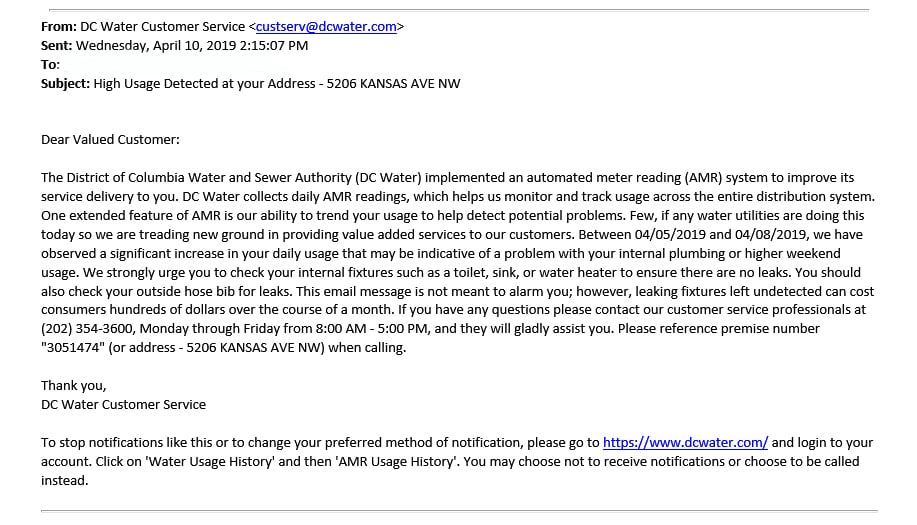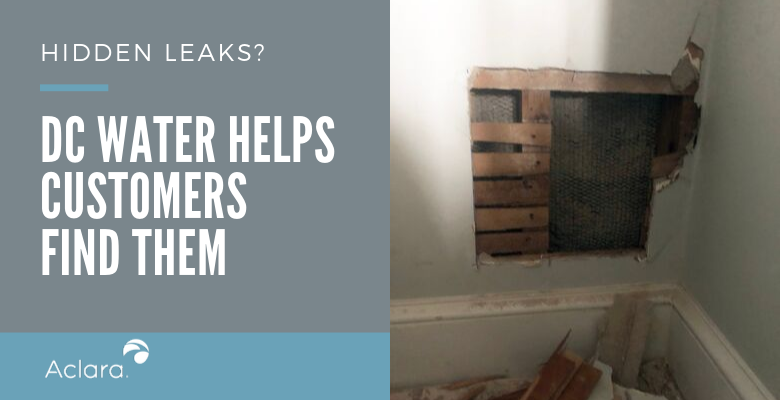People move into older homes because of their beauty and character, but they also expect to find hidden problems that need to be fixed. What they don’t expect is help from their local water utility in identifying those problems.
That is exactly the situation one Washington, D.C homeowner who had just moved into a century-old home discovered himself in when he received this notice from the customer service department of DC Water:

The notice explained that the utility uses data collected from its advanced metering infrastructure system to track usage across its entire system. It looks at the data to identify high-usage patterns that may cause high customer bills.
Alexander Esfahani, the homeowner in question, is married to an Aclara employee who at the time was attending CS Week, a trade show focused on ways utilities can improve customer service.
“The irony of receiving this notice while my wife was attending a conference on how utilities can improve customer service was not lost on me,” said Esfahani. “After being notified I looked for leaks or dripping faucets but didn’t see anything obvious. I hired a plumber to take a closer look.”
What the plumber found, a corroded pipe inside the wall in an extra bathroom, was quickly fixed, saving Esfahani the hundreds of dollars it may have cost in high water bills if the leak had gone undetected for a long time. Not only would Esfahani’s water bill be high, but the water spilling undetected into the wall could have caused structural damage.
Inside the program
Esfahani benefited from a program run by DC Water that looks for unusual usage patterns in the data collected by DC Water’s advanced metering infrastructure (AMI) system. Although other water utilities have similar programs, few have existed for as long as DC Water’s. First begun in 2006, DC Water’s program analyzes the data collected each day by the utility from its Aclara RF AMI network to identify and notify customers when it spots unusual water consumption.
To identify potential problem consumption, the utility looks at the historical daily consumption pattern of each customer and compares it to consumption over a period of three or four days. Usage over a certain threshold, typically set at four times a customer’s typical daily consumption, triggers a notice to the customer. DC Water notifies via phone, email and text.
The utility has refined the program over time, said Carolyn Mackool, director of customer care at DC Water. For example, although customers are opted into the notification program automatically, they can specify the threshold at which they will receive a notice.
“The system is looking at daily consumption, and people can make the threshold as small or as large as they want to set it. Customers have differing opinion on how tightly they want to monitor their consumption,” said Mackool.
Although the default setting is four times daily consumption, DC Water customers can set thresholds as low at 25% over daily consumption, or as high as 12 times daily consumption. Customers’ individual use of water can affect where they set their thresholds.
“Consumption can vary depending on when a customer is home and how big a family they have. For example, people who work and are not home all day are going to see higher consumption during a weekend,” added Mackool. “So, that’s why we let customers set their thresholds in a place that says, ‘Hey, this really looks unusual.’ “
Expanding the program
DC Water continuously works to improve its notification program, said Mackool, Whereas the program previously let customers know if their daily usage was higher than historic norms, it recently added what the utility calls a High Usage Notification Alert (HUNA) program to identify when water is running constantly for more than 24 hours. Continuous flow almost always indicates there is a problem, because in most households there are time periods when water isn’t being used, such as the middle of the night.
“In the past, we just let customer know when a pattern looked unusual, although there could be some rationale for higher usage, like someone has house guests or is filling a pool. The HUNA program enables us to tell a customer that that there definitely is a problem, that something is broken, because no one consumes water continuously for a long duration of time,” said Mackool.
Again, DC Water has made continuous flow notifications completely customizable. The utility defaults the feature to 24 hours over a certain volume, but customers can either set 6 consecutive hours, 12 consecutive hours, or 24. When the threshold is hit the customer receives a notification.
The big hurdle
The biggest problem faced by DC Water in administering its notification program is getting customers to respond to the information it provides.
“A lot of times we will notify customers, and they won’t respond. Or, we do not have good contact information,” said Mackool. “So, we’re really looking for ways to improve communications with our customers. We’re still working on how to get the word out.”
One of the ways that the utility educates its customers is through videos on its website. It currently offers a range of videos that help customers understand the HUNA program as well as to adjust their settings.
Sometimes education takes the form of a hard lesson, when a customer ignores an alert notification.
“Customers will call and say, ‘Hey, I got this notice that said: High Usage. I don’t think I’ve consumed more. Help me understand.’ The representative on the phone will go ahead and look at the AMI data and when they got the original notification. Depending upon their review of the pattern, they’ll be able to tell them what the problem might be,” said Mackool.
These customers are not out of luck, however. The utility will help them find ways to fix the problem and may even forgive some part of a high-water bill, depending on the circumstances.
“This program does make a difference. I think our customer complaints would be higher if we didn’t send notices,” said Mackool.
For more on how utilities can use data to pinpoint real and apparent water loss, download our white paper.

